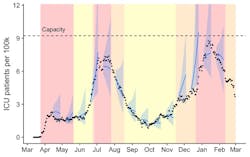COVID forecasting using hospital and cell phone data proves it can reliably guide US cities through pandemic threats
The University of Texas at Austin has reliably forecasted regional hospital demands for almost two years, using cell phone mobility data and COVID-19 hospital admissions data, researchers according to a new study published in the Proceedings of the National Academy of Sciences (PNAS).
The forecasting system, which municipal authorities credit with helping Austin maintain the lowest COVID-19 death rate among all large Texas cities, has been built out for use by 22 municipal areas in Texas and can be used by any city to guide COVID-19 responses as the virus continues to spread.
The scientific team—collaborating with Austin city elected leaders, public health officials and healthcare system executives—developed a powerful forecasting model and two public-facing dashboards that allowed city leaders to manage health care resources, ensure sufficient hospital capacity and communicate pandemic risks to the public.
When the model was developed in the first months of the pandemic, it stood out among other forecasts that were available online. For example, the UT model incorporated detailed public movement data and hospital admissions data long before the Institute for Health Metrics and Evaluation (IHME) model by the University of Washington. The model also provides city-level rather than state-level forecasts that are vital for anticipating and managing COVID-19 health care surges. To do so, it incorporates detailed information about the ages and health risks of local residents.
The forecasting dashboards developed by the UT COVID-19 Modeling Consortium use intuitive graphics and spaghetti lines from hurricane forecasting to communicate the immediate and future risks of COVID-19. The daily online forecasts have been helping Austin residents and local officials make life-saving decisions since the spring of 2020. The model can be adapted to project COVID-19 healthcare needs in any U.S. city three weeks in advance. It uses anonymized cell phone mobility data from SafeGraph, which indicates how much time people stay at home and how frequently they visit points of interest such as bars, restaurants and schools. These data reflect how behaviors change daily in response to changing COVID-19 conditions.
“Community movement data helps us gauge changing COVID-19 transmission risks and anticipate health care surges several weeks in advance,” said Spencer Fox, corresponding author and associate director of the UT COVID-19 Modeling Consortium.
The team also measured the relationship between mobility and COVID-19 transmission and found that precautionary measures, such as face masks and social distancing, reduced the risks of transmission when people were out in public.
Data-driven policies and effective health messaging have helped Austin to keep its COVID-19 death rate the lowest among all large Texas cities.
